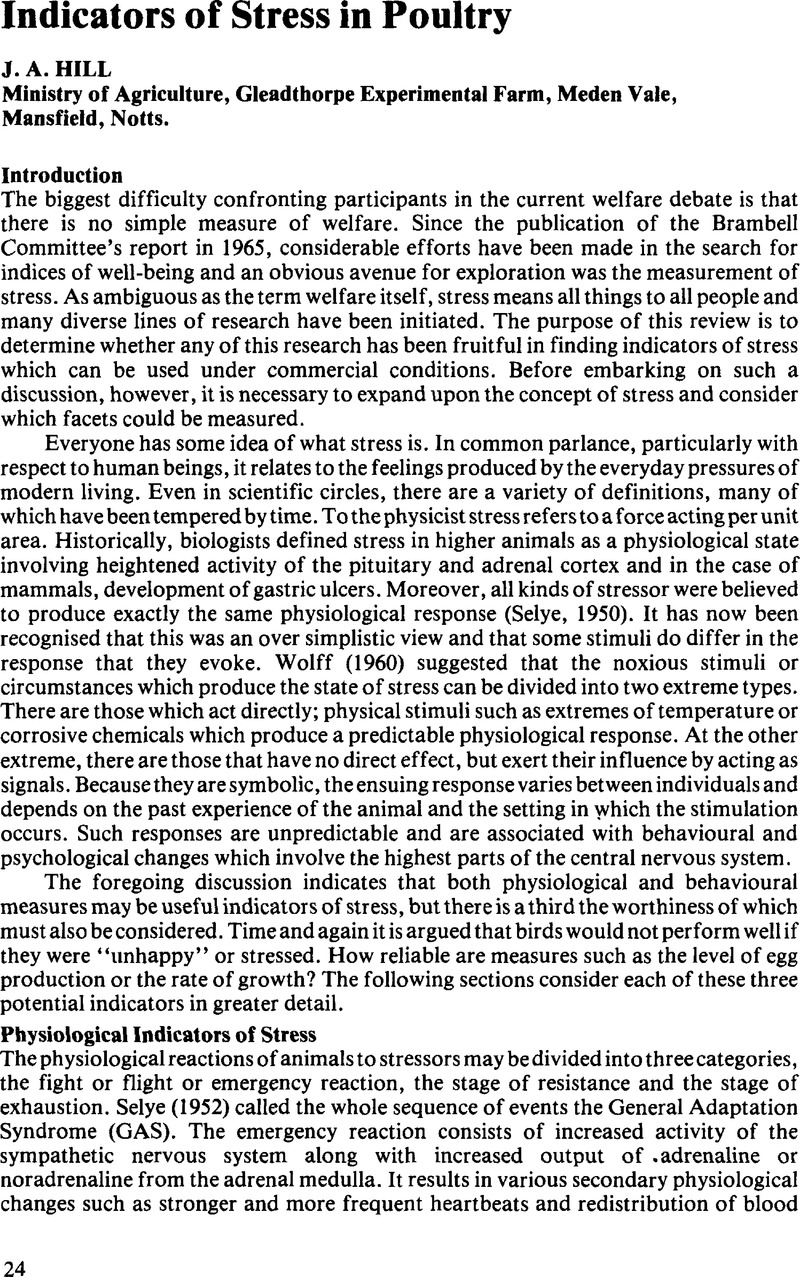Crossref Citations
This article has been cited by the following publications. This list is generated based on data provided by Crossref.
FRASER, D.
and
SIBBALD, I.R.
1983.
The Effects of Precision Feeding on the Behavior of Adult Cockerels.
Poultry Science,
Vol. 62,
Issue. 11,
p.
2224.
Craig, J. V.
and
Adams, A. W.
1984.
Behaviour and Well-being of Hens (Gallus Domesticus) in Alternative Housing Environments.
World's Poultry Science Journal,
Vol. 40,
Issue. 3,
p.
221.
STONE, N.D.
SIEGEL, P.B.
ADKISSON, C.S.
and
GROSS, W.B.
1984.
Vocalizations and Behavior of Two Commercial Stocks of Chickens.
Poultry Science,
Vol. 63,
Issue. 4,
p.
616.
KOELKEBECK, K.W.
and
CAIN, J.R.
1984.
Performance, Behavior, Plasma Corticosterone, and Economic Returns of Laying Hens in Several Management Alternatives.
Poultry Science,
Vol. 63,
Issue. 11,
p.
2123.
Freeman, B. M.
1984.
Transportation of Poultry.
World's Poultry Science Journal,
Vol. 40,
Issue. 1,
p.
19.
CRAIG, J.V.
and
CRAIG, J.A.
1985.
Corticosteroid Levels in White Leghorn Hens as Affected by Handling, Laying-House Environment, and Genetic Stock.
Poultry Science,
Vol. 64,
Issue. 5,
p.
809.
KOELKEBECK, K.W.
CAIN, J.R.
and
AMOSS, M.S.
1986.
Corticosterone Sampling of Laying Hens in Different Management Systems.
Poultry Science,
Vol. 65,
Issue. 1,
p.
183.
CRAIG, J.V.
CRAIG, J.A.
and
VARGAS, J. VARGAS
1986.
Corticosteroids and Other Indicators of Hens’ Well-Being in Four Laying-House Environments.
Poultry Science,
Vol. 65,
Issue. 5,
p.
856.
Gibson, S. W.
Hughes, B. O.
Harvey, S.
and
Dun, P.
1986.
Plasma concentrations of corticosterone and thyroid hormones in laying fowls from different housing systems.
British Poultry Science,
Vol. 27,
Issue. 4,
p.
621.
MENCH, J.A.
van TIENHOVEN, A.
MARSH, J.A.
McCORMICK, C.C.
CUNNINGHAM, D.L.
and
BAKER, R.C.
1986.
Effects of Cage and Floor Pen Management on Behavior, Production, and Physiological Stress Responses of Laying Hens.
Poultry Science,
Vol. 65,
Issue. 6,
p.
1058.
Karunajeewa, H.
1987.
A review of current poultry feeding systems and their potential acceptability to animal welfarists.
World's Poultry Science Journal,
Vol. 43,
Issue. 1,
p.
20.
Cunningham, D.L.
van Tienhoven, A.
and
De Goeijen, F.
1987.
Dominance rank and cage density effects on performance traits, feeding activity and plasma corticosterone levels of laying hens (Gallus domesticus).
Applied Animal Behaviour Science,
Vol. 17,
Issue. 1-2,
p.
139.
KOELKEBECK, K.W.
AMOSS, M.S.
and
CAIN, J.R.
1987.
Production, Physiological, and Behavioral Responses of Laying Hens in Different Management Environments.
Poultry Science,
Vol. 66,
Issue. 3,
p.
397.
Dawkins, Marian Stamp
1988.
Behavioural deprivation: A central problem in animal welfare.
Applied Animal Behaviour Science,
Vol. 20,
Issue. 3-4,
p.
209.
Cashman, P. J.
Nicol, Christine J.
and
Jones, R. B.
1989.
Effects of transportation on the tonic immobility fear reactions of broilers.
British Poultry Science,
Vol. 30,
Issue. 2,
p.
211.
GRAY, H.G.
PARADIS, T.J.
and
CHANG, P.W.
1989.
Research Note: Physiological Effects of Adrenocorticotropic Hormone and Hydrocortisone in Laying Hens.
Poultry Science,
Vol. 68,
Issue. 12,
p.
1710.
Archer, John
1990.
Ethological motivational theory as a basis for assessing animal suffering.
Behavioral and Brain Sciences,
Vol. 13,
Issue. 1,
p.
12.
Chapman, C. Richard
1990.
On the neurobiological basis of suffering.
Behavioral and Brain Sciences,
Vol. 13,
Issue. 1,
p.
16.
Jackson, Frank
1990.
Singer's intermediate conclusion.
Behavioral and Brain Sciences,
Vol. 13,
Issue. 1,
p.
24.
Magurran, Anne E.
1990.
Obtaining and applying objective criteria in animal welfare.
Behavioral and Brain Sciences,
Vol. 13,
Issue. 1,
p.
26.



